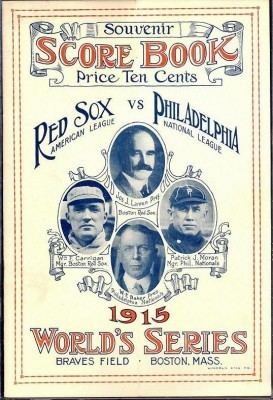Dates 8 Oct 1915 – 13 Oct 1915 | ||
Hall of Famers Umpires: Bill Klem, Billy Evans Red Sox: Harry Hooper, Herb Pennock (dnp), Babe Ruth, Tris Speaker.Phillies: Grover Cleveland Alexander, Dave Bancroft, Eppa Rixey. Similar 1916 World Series, 1912 World Series, 1918 World Series, 1914 World Series, 1913 World Series | ||
In the 1915 World Series, the Boston Red Sox beat the Philadelphia Phillies four games to one.
Contents
In their only World Series before 1950, the Phillies won Game 1 before being swept the rest of the way. It was 65 years before the Phillies won their next Series game. The Red Sox pitching was so strong in the 1915 series that the young Babe Ruth was not used on the mound and only made a single pinch-hitting appearance.
Series arrangements
Arrangements for the Series were made on October 2, 1915, in a meeting of the team owners, league presidents and the so-called National Commission at the Waldorf-Astoria Hotel in midtown Manhattan, New York City. Red Sox owner Joseph Lannin lost the coin toss for home field advantage, and Phillies owner William F. Baker chose to have the first two games of the Series in Philadelphia. The league presidents selected the umpires, and it was announced that J. G. Taylor Spink would be one of the official scorers.

One controversy surrounded the allocation of tickets to the Red Sox' Royal Rooters fan club. Each visiting team was allocated 200 tickets, but the Red Sox requested an additional 400 on behalf of their supporters. The Phillies' Baker Bowl sat only 20,000, and their above-cited owner, William Baker, refused to allocate additional tickets for visiting fans. The matter was resolved by National Commission chairman Garry Herrmann, who gave the Red Sox tickets from the Commission's own Series allocation.
Series summary

The Phillies won Game 1, 3–1, although New York Times reporter Hugh Fullerton wrote of the future 300+ game-winning Hall of Famer, "[Grover Cleveland] Alexander pitched a bad game of ball. He had little or nothing" in his review of the game, headed "Nothing but luck saved the Phillies." The Times also reported that a crowd of 10,000 gathered in Manhattan's Times Square to view a real-time mechanical recreation of the game on a giant scoreboard sponsored by the newspaper.
The Phillies were not to win another postseason game until 1977, nor another World Series game until 1980. The Red Sox swept Games 2–5, all by one run, and by identical scores of 2–1 in Games 2–4.
In Game 2, Woodrow Wilson became the first U.S. President to attend a World Series game.

This was the second straight year that a Boston team beat a Philadelphia team in the World Series after the Braves had swept the Athletics the year before.
Unlike the 1913 Series, where the home team won only one of the five games, home field was often very much an advantage in the 1915 October classic. Fenway Park, paradoxically the Braves' home field in their 1914 Series sweep of the A's while Braves Field was still being built, had been the home of the Red Sox for four seasons and was fully functional in 1915; yet the Red Sox played their 1915 Series "home" games in the brand-new Braves Field to take advantage of its larger seating capacity. Beyond the added revenue, the long ball was affected by this arrangement, as follows:
Summary
AL Boston Red Sox (4) vs. NL Philadelphia Phillies (1)
Game 5
The Red Sox won on three home runs by two of their outfielders, two cheapies by Harry Hooper (see above) and one by Duffy Lewis. Those were the only round-trippers in the entire Series, the first four games being pitchers' duels.
Composite line score
1915 World Series (4–1): Boston Red Sox (A.L.) over Philadelphia Phillies (N.L.)
